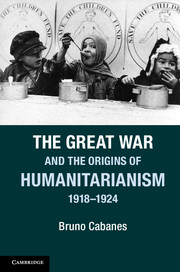Book contents
- Frontmatter
- Contents
- Acknowledgments
- Introduction Human disasters: humanitarianism and the transnational turn in the wake of World War I
- 1 “Rights, not charity”: René Cassin and war victims
- 2 Justice and peace: Albert Thomas, the International Labor Organization, and the dream of a transnational politics of social rights
- 3 The tragedy of being stateless: Fridtjof Nansen and the rights of refugees
- 4 The hungry and the sick: Herbert Hoover, the Russian famine, and the professionalization of humanitarian aid
- 5 Humanitarianism old and new: Eglantyne Jebb and children's rights
- Conclusion Human dignity: from humanitarian rights to human rights
- Further reading
- Bibliography
- Index
- References
3 - The tragedy of being stateless: Fridtjof Nansen and the rights of refugees
Published online by Cambridge University Press: 05 June 2014
- Frontmatter
- Contents
- Acknowledgments
- Introduction Human disasters: humanitarianism and the transnational turn in the wake of World War I
- 1 “Rights, not charity”: René Cassin and war victims
- 2 Justice and peace: Albert Thomas, the International Labor Organization, and the dream of a transnational politics of social rights
- 3 The tragedy of being stateless: Fridtjof Nansen and the rights of refugees
- 4 The hungry and the sick: Herbert Hoover, the Russian famine, and the professionalization of humanitarian aid
- 5 Humanitarianism old and new: Eglantyne Jebb and children's rights
- Conclusion Human dignity: from humanitarian rights to human rights
- Further reading
- Bibliography
- Index
- References
Summary
“I thought I saw a whole city before me with its thousands of lights—it was their camps spread out over the plain, camp-fire by camp-fire, and there they were sleeping on the ground without shelter of any kind…They do not know where they are going and will find no shelter where they come.”
Fridtjof Nansen in Constantinople, September 1922, on the sight of refugees of Greek origin fleeing the massacres of the Turkish army.“The possibility of obtaining an international passport would be a practical solution, but more than that, it would be an important political and moral act that would free Russian citizens abroad from the Soviet yoke.”
Boris Mirkine-Guetzévitch, “Le passeport international,” La Tribune Juive, March 13, 1922.For four long years, from 1914 to 1918, the war had created vast movements of displaced populations, civilians who had to flee ahead of invading troops, or who were driven out by force during military occupations on both the Western and Eastern fronts. From 1918 to 1922, large numbers of refugees continued to be on the move in Europe. The collapse of the vast multi-ethnic Austro-Hungarian, Russian, and Ottoman Empires had given birth to smaller nation-states that often forced ethnic minorities to leave. The refugee groups included many people driven from their homes by war, religious persecution, or poverty. Several hundred thousand Magyars were expelled from Romania, Czechoslovakia, and Yugoslavia, and migrated to Hungary. After the war, when Alsace-Lorraine returned to French control, the government classified its population into four categories and deported thousands of ethnic Germans during the winter of 1918–19, even if they no longer had any contact with or ties to Germany. Russian refugees fled from oppression, poverty, and hunger. After the genocide of 1915, in which over a million Armenians died, survivors fled to Soviet Armenia, Syria, and other countries.
- Type
- Chapter
- Information
- The Great War and the Origins of Humanitarianism, 1918–1924 , pp. 133 - 188Publisher: Cambridge University PressPrint publication year: 2014
References
- 1
- Cited by



